What Is an Ice Dam | How to Remove Ice Dam From Roof | What Causes Ice Dams on Roof | How to Remove Ice Dams
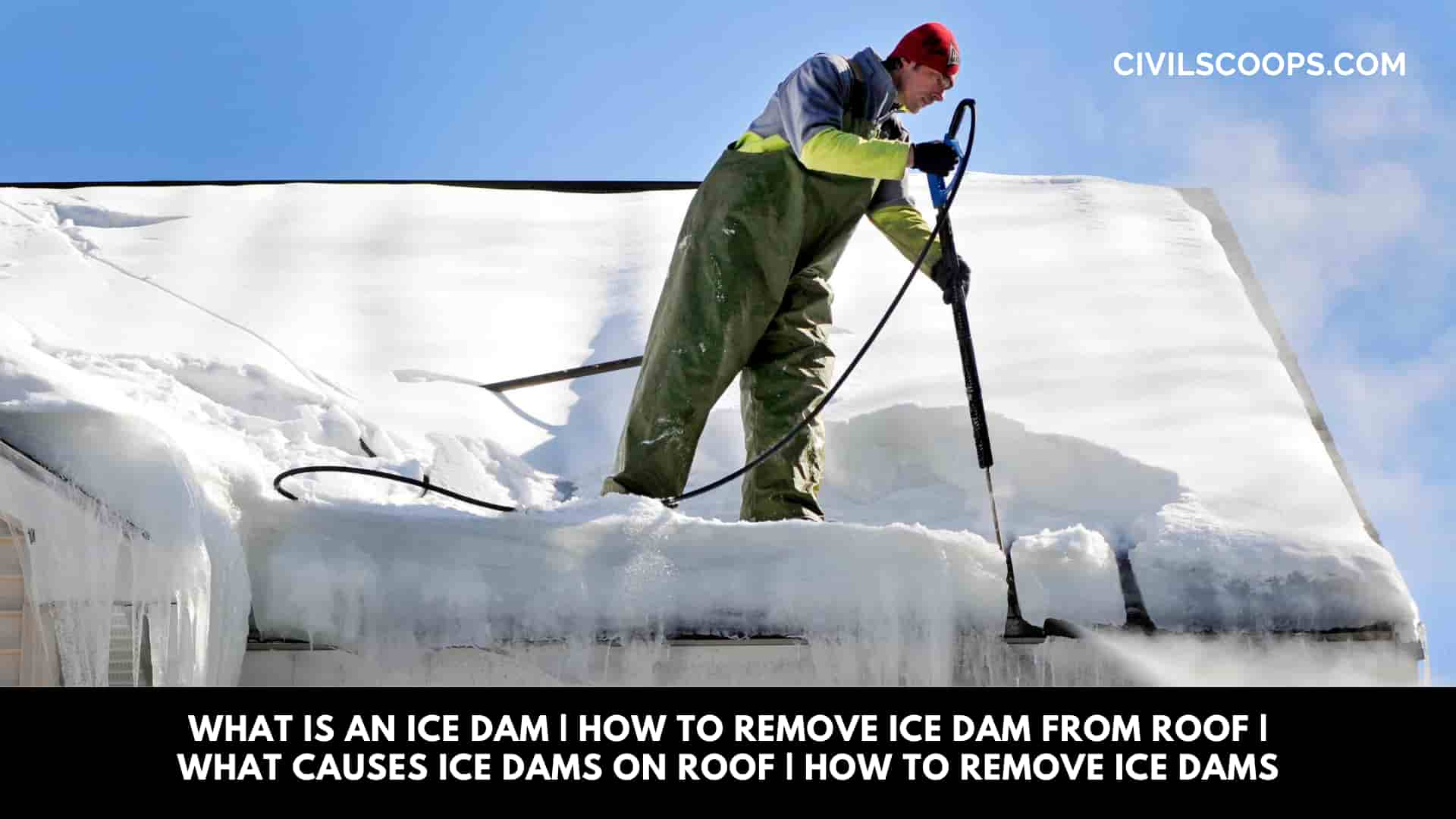
Table of Contents
What Is an Ice Dam?
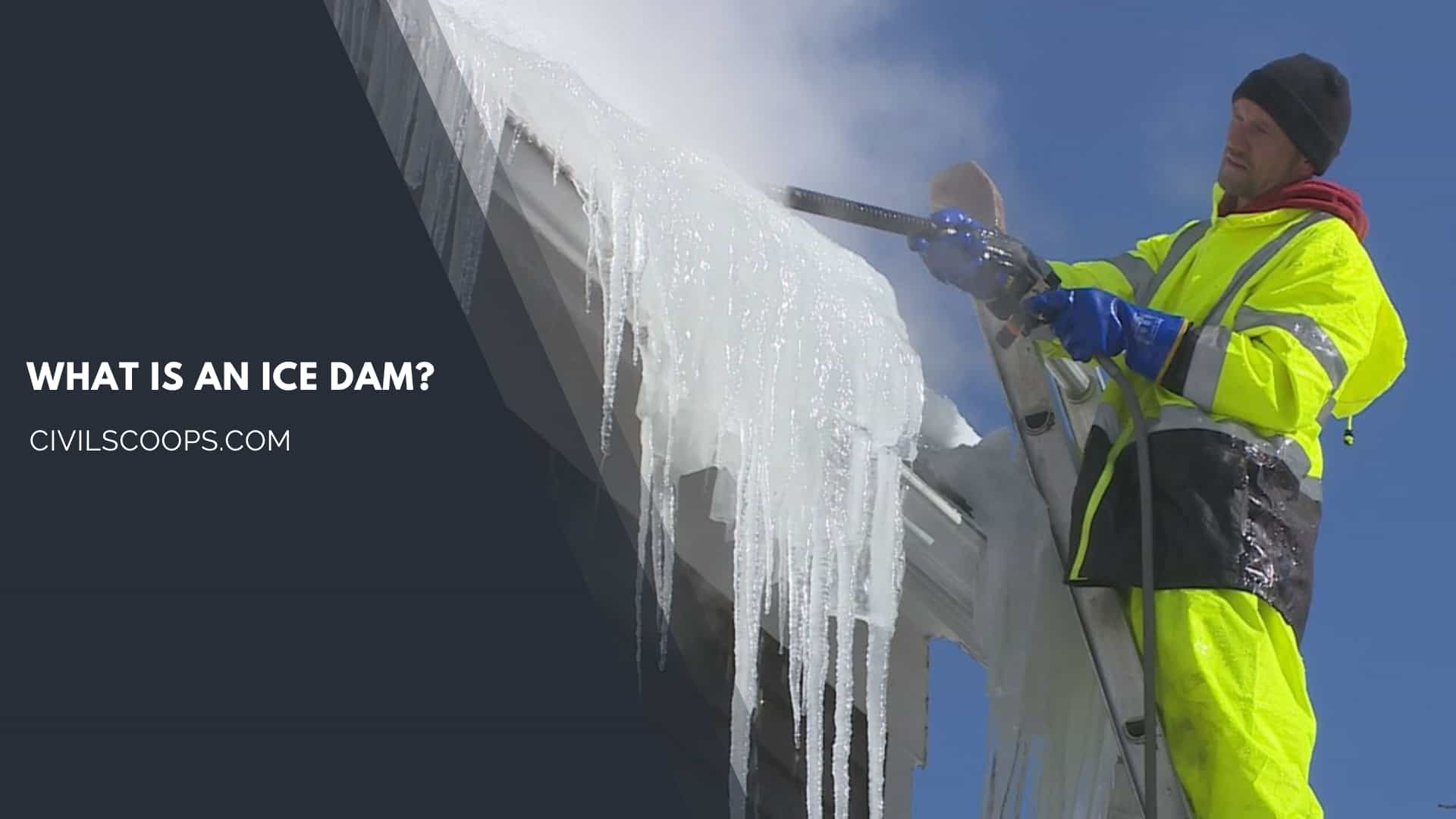
Generally, ices are very beautiful in nature, but they can also cause many problems like shingles to get looses, tear off gutters, water can get back into the indoor portion of your house, etc.
So, here we fix those problems, prevention, and long-time repair process. In the winter region, Icicles are hanging from the eaves of the house and look very beautiful, but later it can cause some huge problems.
Due to excessively cold weather, snow is stored in the roof and freezes along the eaves and creates a dam-like structure which is called an ice dam. It causes serious and major problems.
How to Remove Ice Dams from Roof?
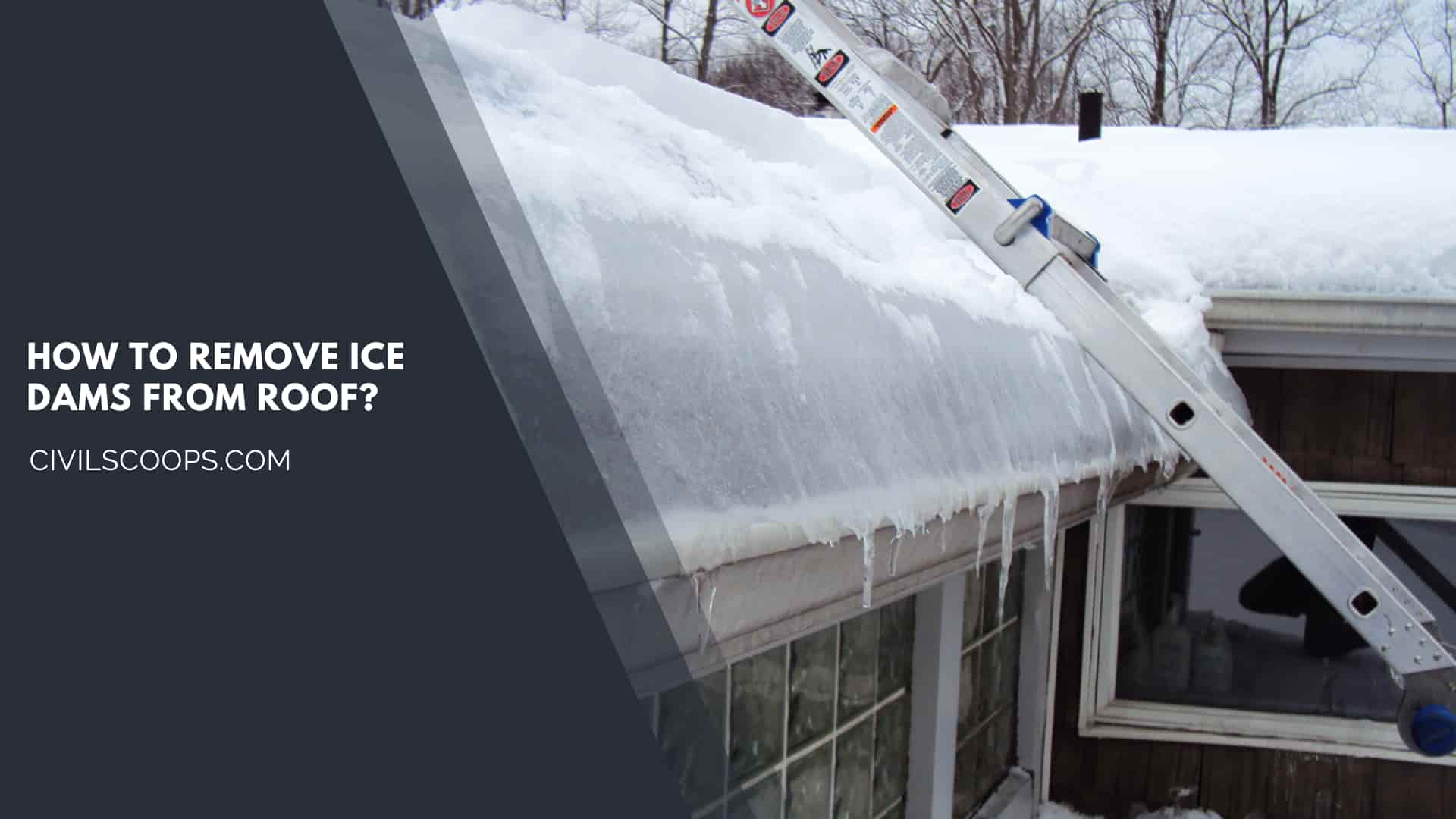
There are three methods that are widely used, those are.
1. Blow-In Cold Air
If we use a hammer, chisel, shovel, etc., then it will be very bad for your roof strength. For melting purposes, we salt, but it damages the same amount of the previous type.
To stop the water leaking, we need to take a box fan and aim to the under portion of the roof where the leak is happening. Then by cold air, the leakage water will freeze again and be converted to the ice again. Like this process, we can easily stop the leaking problem due to the ice dam.
2. Rake It
This is another process to rid of an ice dam; here, you can pull off the snow with a long-handled tool maintaining a safe distance. This is the easiest and economical method among all of these.
3. De-Icing Method
This is another process where we put a calcium chloride ice melter into the ice. Then we lay that hose to the roof because it can cross the ice dam and overhang the gutter.
After that, we push the calcium chloride melter by the long-handled tool. Finally, the calcium chloride melter melted the ice and cleared off with a water channel.
How to Remove Ice Dam From Roof?
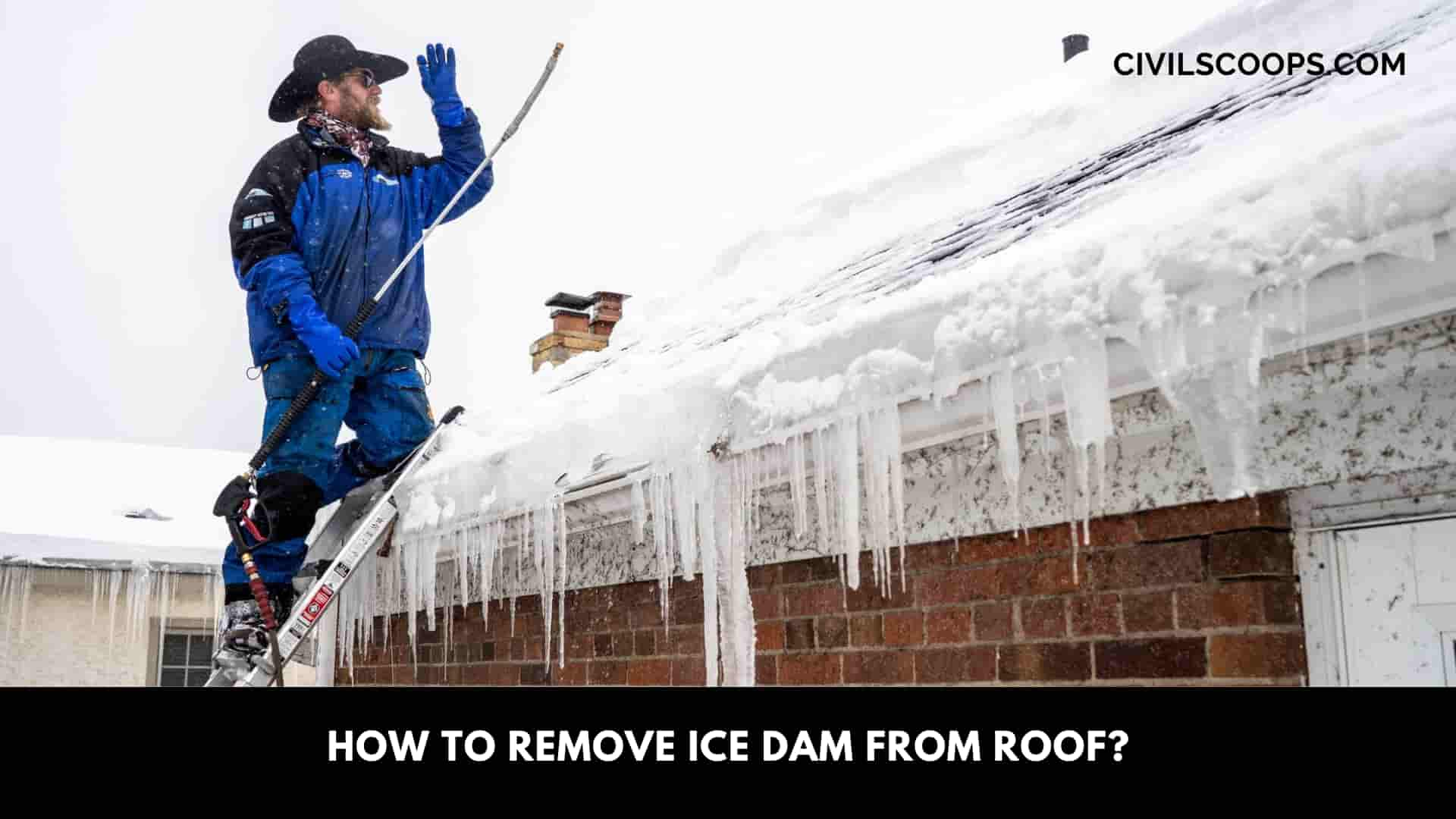
Ice dam removal is not an easy process; here, we use calcium chloride melter to melt the ice. So, there are some few steps, those are-
- By using a roof rake, we need to remove the snow of height 3 to 4 feet from the edge of the roof. We need to be very careful about the roof covering areas like emergency exits, walking paths, etc.
- Then, we need to use a calcium chloride ice melter to melt the ice. Don’t use sodium chloride melter because it can cause serious roof damages.
- After that, we fill that part with calcium chloride ice melt with a nylon stocking.
- Then, we place the calcium chloride melter, which is filled with a nylon stocking, vertically across an ice dam to melt a channel through the ice.
- We need to protect the shrubbery or plants near the gutters or downspouts because the place where the melted water will drop can cause damage because the calcium chloride water is very harmful to shrubbery or plants.
How to Get Rid of Ice Dams on Roof?
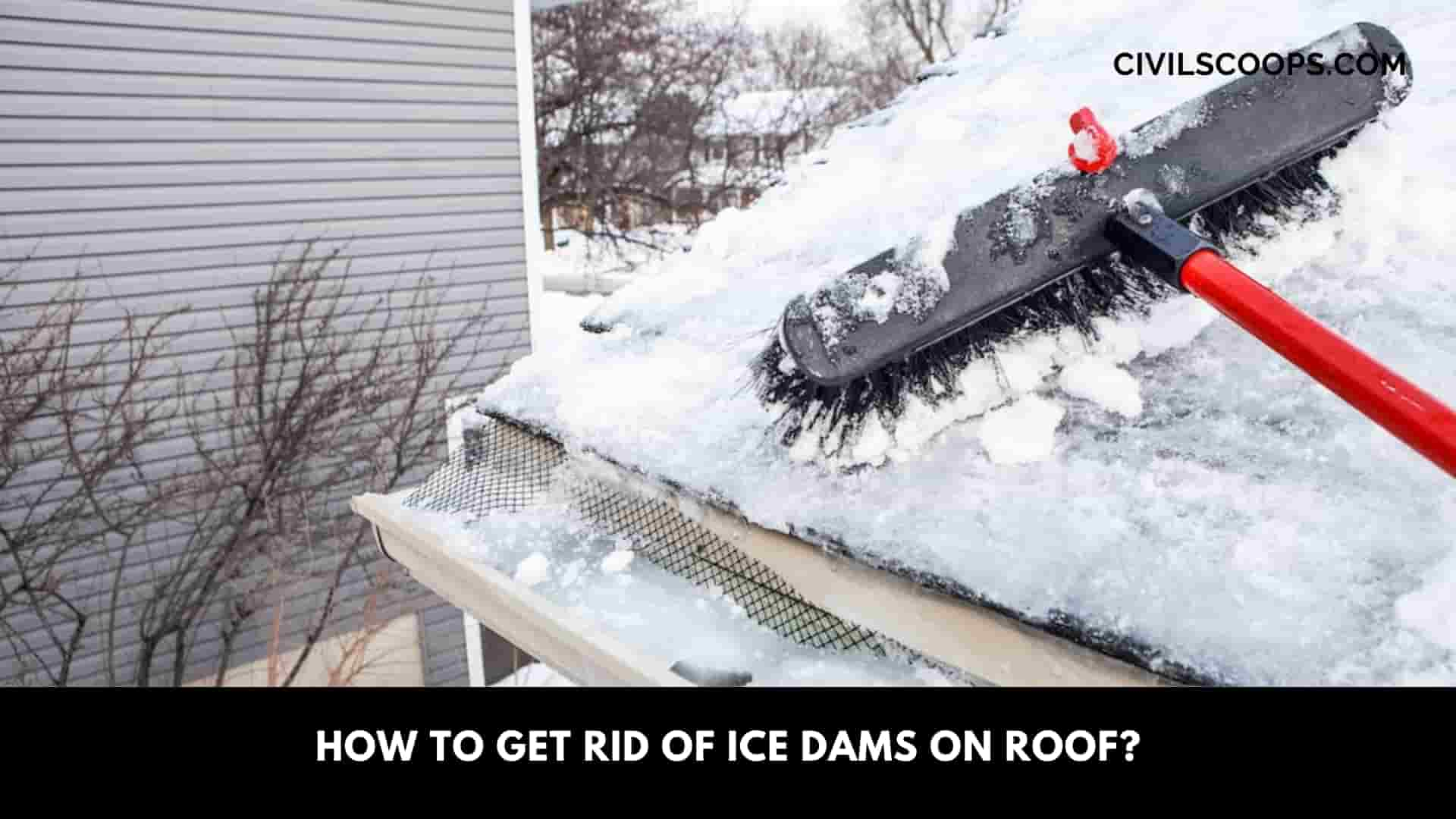
There are naturally five ways available to remove ice dams from the roof, those are-
1. Eliminate the “Fuel Source”
The creation of an ice dam is a natural and spontaneous process; if you left it, then it will create more and more. So, to remove that ice dam, we need to apply the first step, which is removing the snow with the long-handled snow rake, which is extended up to 17 feet in length.
Then stand on the ground and scrape the snow down off from the roof but don’t use a ladder or don’t stand in the roof. Make sure that you must pull the snow in a vertical direction towards you, not in the horizontal direction. Wrong activities can damage the roof shingles.
2. Chip Away
This is the second step where you need an ice pick or awl. Here you can stand on the ladder, chip away the ice. Here, you don’t remove all the ice from the roof; you just need a channel for the melted snow and ice that can go through the gutters.
3. Use a Chemical De-Icer Product
Here, we use a urea fertilizer, ammonium sulfate, calcium magnesium sulfate, potassium chloride, etc. Then we need to place it on the top of the ice, which will melt the ice slowly, and the water will drain out slowly by the gutters.
4. Reuse of Old Stocking or Pantyhose
We need to fill these with chemical de-icer lay them on the top of the gutters, which melts the ice. This is a time-consuming process, and it needs to reposition the materials.
5. Spray Warm Water
This process is used for an instant solution that obtains hot or warm water in a pot, which needs to spray along the ice. You need to use it in the junction area unless that hot water turns cold and freezes again.
Also Read: What Are Curb and Gutter | Types of Curb and Gutter| Advantages & Disadvantages of Curb and Gutter
How to Stop Ice Dams in Gutters?
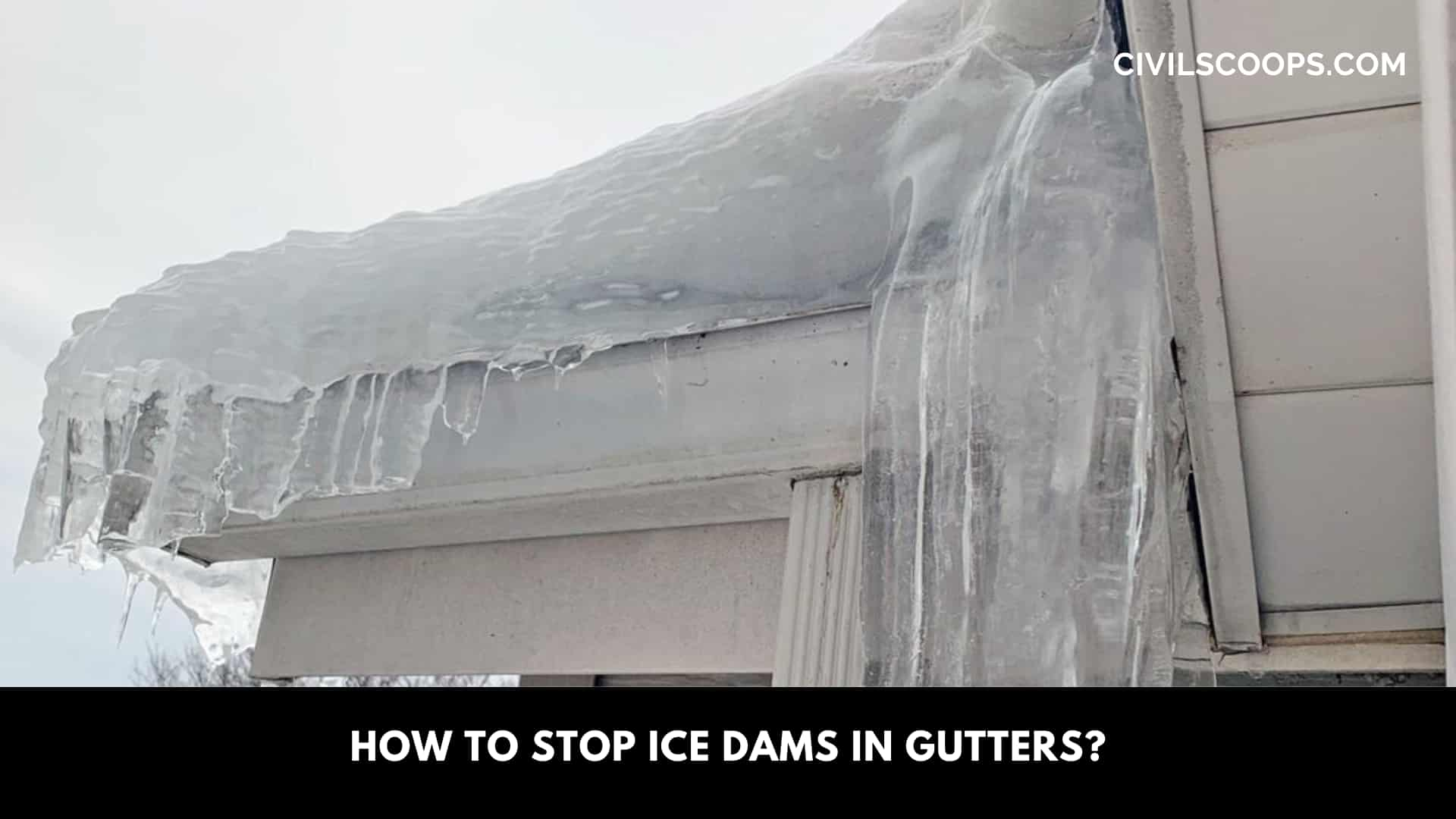
There are some processes available for ice melting in gutters, those are-
1. Roof Tablets

Roof tablets are very safe products that create channels to drain out the melted water. It is a safety process where you just create some holes into the ice where you put those tablets. It does not require too much money.
2. Pantyhose Filled with Salt
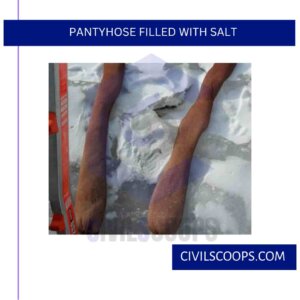
It is a safe method, and it takes too much time, but this is the best method among all of these. Plain salt is used in this process.
3. Heated Cables

These cables can resist any further formation of an ice dam, but these create some hazards, so we do not recommend this.
4. Hot Water Hose
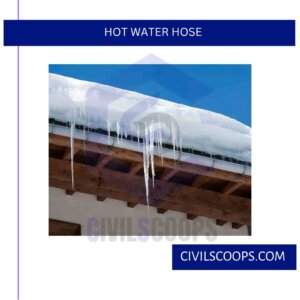
A hot water hose is used for an instant solution that obtains hot or warm water in a pot, which needs to spray along the ice. It is used in the junction area unless that hot water turns cold and freezes again.
Also Read: Grey Water vs Black Water | What Is Grey Water | What Is Black Water
How to Prevent Ice Dams on a Metal Roof?
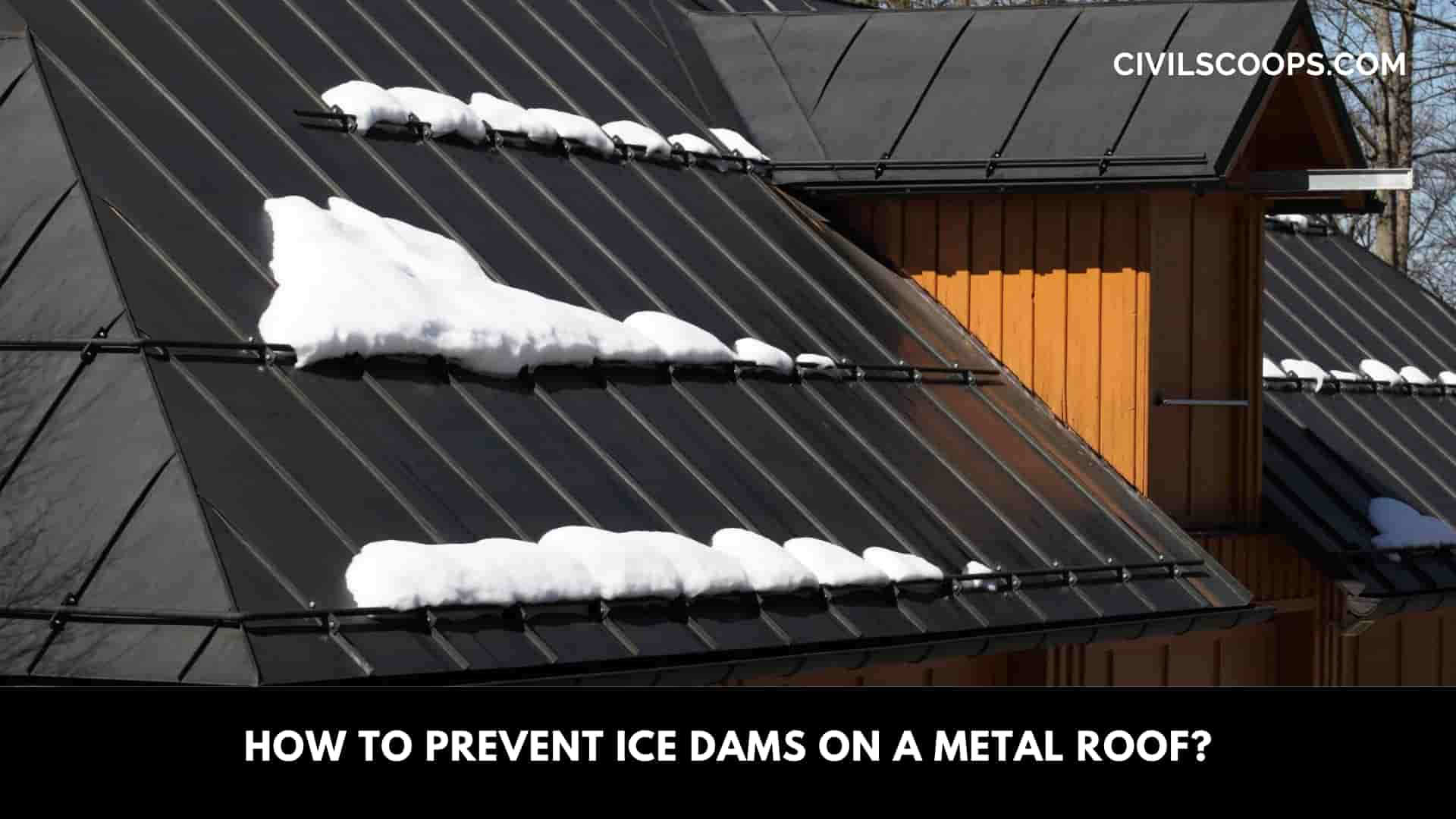
Here, Prevent ice dams on roof are as follows.
1. Prevention
The only prevention process of an ice dam is using a heated cable. Here, you can attach the roof edge in the zigzag pattern, but due to heated cables, roof shingles lift and causes minor leakage. You need to fix those cables before the bad weather otherwise it can not be fixed properly.
2. Fast Fixes
There are some methods available in the market, those are-
2.1. Ventilate Eaves and Ridge:
Generally, a ridge vent is paired with a soffit that circulates the air flows; the opening must be 1 square foot of opening for every 300 square feet. We need to place baffles in the eaves to provide airflow.
2.2. Cap the Hatch
A house fan or attic hatch is a major opening to escape the heat; so, you need to cover up those with foil-faced foam board to bind with aluminum tape.
2.3. Exhaust to the Outside
You need some care about all the ducts coming from the kitchen, bathroom, etc. are finished through the roof or wall but never through the soffit.
2.4. Add Insulation
An insulation process is required to keep the heat; you can contact some local building departments.
2.5. Installed Sealed Can Lights
Old style lights are good in the heat-generating so, it’s good to use. “IC” fixtures are also used in place of that lights; they are covered and insulated.
2.6. Flash Around Chimneys
Here, reduce the gap between the chimney and L-shaped steel flashing for insulation purposes.
2.7. Caulk Penetration
Electric cable and vent pipes are protected with fire-stop sealant need extra care for dirt because it prevents air circulation.
[su_box title=”FAQ” style=”default” box_color=”#333333″ title_color=”#FFFFFF” radius=”3″ class=”” id=””]
What Is an Ice Dam?
An ice dam is an ice build-up on the eaves of sloped roofs of heated buildings that results from melting snow under a snow pack reaching the eave and freezing there.
What Causes Ice Dams?
They occur when heavy snow buildup melts during the day and then refreezes when temperatures drop overnight. After several days of melting-freezing cycles, it’s common for the melted water and ice to work up under the shingles until water enters the attic and eventually does damage to the ceilings, wall and contents.
What Does an Ice Dam Look Like?
An ice dam is a ridge of ice that forms at the edge of a roof and prevents melting snow (water) from draining off the roof. The water that backs up behind the dam can leak into a home and cause damage to walls, ceilings, insulation and other areas.
What Are Ice Dams on a Roof?
Ice dams are ridge-like formations of ice that can develop along the edges of a roof, particularly in cold climates with snowfall. They form when snow on the roof melts due to heat escaping from the interior of the building or from the sun’s rays, and then refreezes at the colder edges of the roof, usually near the eaves (the lower edges of the roof).
What Is an Ice Dam on a Roof?
An ice dam on a roof is a ridge of ice that forms at the edge of a roof, typically near the eaves or gutters. It occurs when snow on the roof melts due to heat escaping from the interior of the building or from the sun’s rays. The melted snowwater then flows down the roof until it reaches the colder edges, where it refreezes, forming a barrier of ice.
What Is the Best Way to Prevent Ice Dams?
Preventing Roof Ice Dams
- Thoroughly clean all leaves, sticks, and other debris from rain gutters and down spouts.
- Strive to keep snow on your roof to a minimum.
- Keep gutters and down spouts clear of snow and icicles all winter.
- Evaluate the insulation and ventilation in your attic.
What Can I Put in My Gutters to Melt Ice?
The Calcium Chloride Stocking Method
The stocking method involves filling old stockings with calcium chloride and tying them off. Then, simply drape them over the frozen section of your gutter and leave them in place until the ice has melted. This method is relatively simple and can be more effective than using salt.
Can You Put Ice Melt in Gutters?
Avoid Chemical-Based Roof Gutter Ice Melt.
This can lead to leaks and other problems. Chemical ice melt can damage your gutters as it contains corrosive chemicals that can damage any metal surface it comes into contact.
What Ice Melt Is Safe for Roofs?
Safe Paw is one brand that can help you safely de-ice your roofs without causing them any damage. It is 100% salt-free and chloride-free, making it safe for the environment, your roofs, and your home in general.
What Is an Ice Dam on Your Roof?
An ice dam on your roof is a ridge of ice that forms along the edges, caused by melting snow refreezing at the colder eaves. It can lead to leaks and damage if not managed. Prevent by insulating, ventilating, and removing snow.
How to Stop Ice Dams in Gutters?
To stop ice dams in gutters:
- Insulate attic.
- Ensure proper ventilation.
- Seal air leaks.
- Use heat cables.
- Clear gutters and downspouts.
- Consider ice/water shield.
- Remove excess snow.
How to Prevent Ice Dams in Gutters?
Battling Ice Dams
- Keep gutters clean.
- Use a roof rake after heavy snowfalls: Ice dams appear quickly after a heavy snow because of the insulating properties of snow.
- Use calcium chloride or an ice-melt product: If you have an ice dam forming, you can apply calcium chloride or a similar product to the ice.
How to Prevent Ice Dams on Low Slope Roofs?
Keeping heavy snow loads off your roof reduces the chances for both ice dam formation and roof failure due to the weight. All winter long, keep gutters and down spouts clear of snow and icicles. Evaluate the insulation and ventilation in your attic.
How to Prevent Ice Dams on Metal Roof?
An ice belt, a band of metal roofing, installed at the eaves helps prevent the formation of ices dams by placing a low-friction surface where ice dams are likely to form. If an ice dam does form, an ice belt will reduce the penetration of standing water.
How to Get Rid of Ice Dams on Roof?
Use a chemical melting agent
Use calcium chloride to melt snow and ice away. One easy ice dam removal tactic is to use calcium chloride pellets, and only calcium chloride, to melt it away. Never use rock salt—it can damage your shingles and ruin any plants that it drips onto below.
How to Remove Ice Dam from Metal Roof?
How to Remove Ice Dams
Step 1: Melt the ice dam with calcium chloride.
Step 2: Break existing ice dams into chunks.
Step 3: Hire a roofing professional.
Step 1: Rake excess snow from the roof after a snowfall.
Step 2: Check for and remove attic heat sources.
Step 3: Add attic insulation.
How to Stop Ice Dams on Metal Roof?
- Insulate Attic: Proper insulation in the attic helps maintain consistent roof temperature, reducing snow melting.
- Ventilate Attic: Ensure good attic ventilation to prevent warm air buildup, which contributes to melting.
- Seal Air Leaks: Close gaps, cracks, and openings that allow warm air to escape into the attic.
- Heat Cables: Install heat cables along the eaves to melt ice and create drainage paths.
- Snow Removal: Use a roof rake to remove excess snow after heavy falls.
- Gutter Clearing: Keep gutters and downspouts clear to facilitate water flow.
How to Fix Ice Damming?
- Rake and remove the melting snow from your rooftop.
- Install ice melt on your roof.
- Use hot water to thaw out the ice dam.
- Avoid chipping away at an ice dam with tools.
- Install the ideal amount of insulation.
- Use a blower door test.
How to Avoid Ice Dams?
Ice dams can be prevented by controlling the heat loss from the home. Remove snow from the roof. This eliminates one of the ingredients necessary for the formation of an ice dam. A “roof rake” and push broom can be used to remove snow, but may damage the roofing materials.
Ice Dam Removal
- Rake Snowfall Off the Roof.
- Add Attic Insulation.
- Seal Interior Airflow Leaks and Ventilate Your Attic.
- Install De-Icing Cables.
- Melt Ice Dams With Calcium Chloride.
- Break Up Ice Dams With a Mallet.
Ice Dam Removal Cost
The national average cost of ice dam removal is between $600 and $1,800. Most people pay around $1,200 for three hours of labor to remove ice from a traditional two-story home with around 1,500 sq. ft.
Repairing Ice Dam Damage
To repair ice dam damage:
- Assess extent of damage.
- Repair water-damaged areas inside.
- Replace damaged shingles.
- Check insulation and ventilation.
- Repair gutters/downspouts.
- Address structural issues if present.
Removing Ice Dams from Roof
Use a chemical melting agent
One easy ice dam removal tactic is to use calcium chloride pellets, and only calcium chloride, to melt it away. Never use rock salt—it can damage your shingles and ruin any plants that it drips onto below. Also, don’t just climb up and sprinkle the calcium chloride on your roof.
Cost of Roof Snow Removal
The national average cost to remove snow from a roof ranges from $250 to $500. Most homeowners pay around $300 to remove 18 inches of snow or ice from a flat roof and no larger than 2,500 sq. ft. Costs can be as low as $150 to remove 12 inches of snow from a 1,500 sq.
How to Remove Ice Dams?
- Safely use a roof rake to clear snow.
- Create water channels to help melt ice.
- Install heat cables along eaves.
- Avoid sharp tools and open flames.
- Consider professionals for extensive ice dams.
- Prevent future dams with insulation and maintenance.
[/su_box]
[su_note note_color=”#F2F2F2 ” text_color=”#333333″ radius=”3″ class=”” id=””]
Like this post? Share it with your friends!
Suggested Read –
- Types of Gable Roof
- What Is Stone Masonry | Types of Stone Masonry
- Different Types of Roofing Materials | What is Roof Covering
- What Is Salt Concrete Finish | How to Create a Salt Finish | Rock Salt Concrete Finish Installation Procedure
- What Does Hail Damage Look Like on a Roof | Identifying Hail Damage to Your Roof | Wood Shingles Hail Damage
[/su_note]
Originally posted 2023-08-10 08:11:29.
